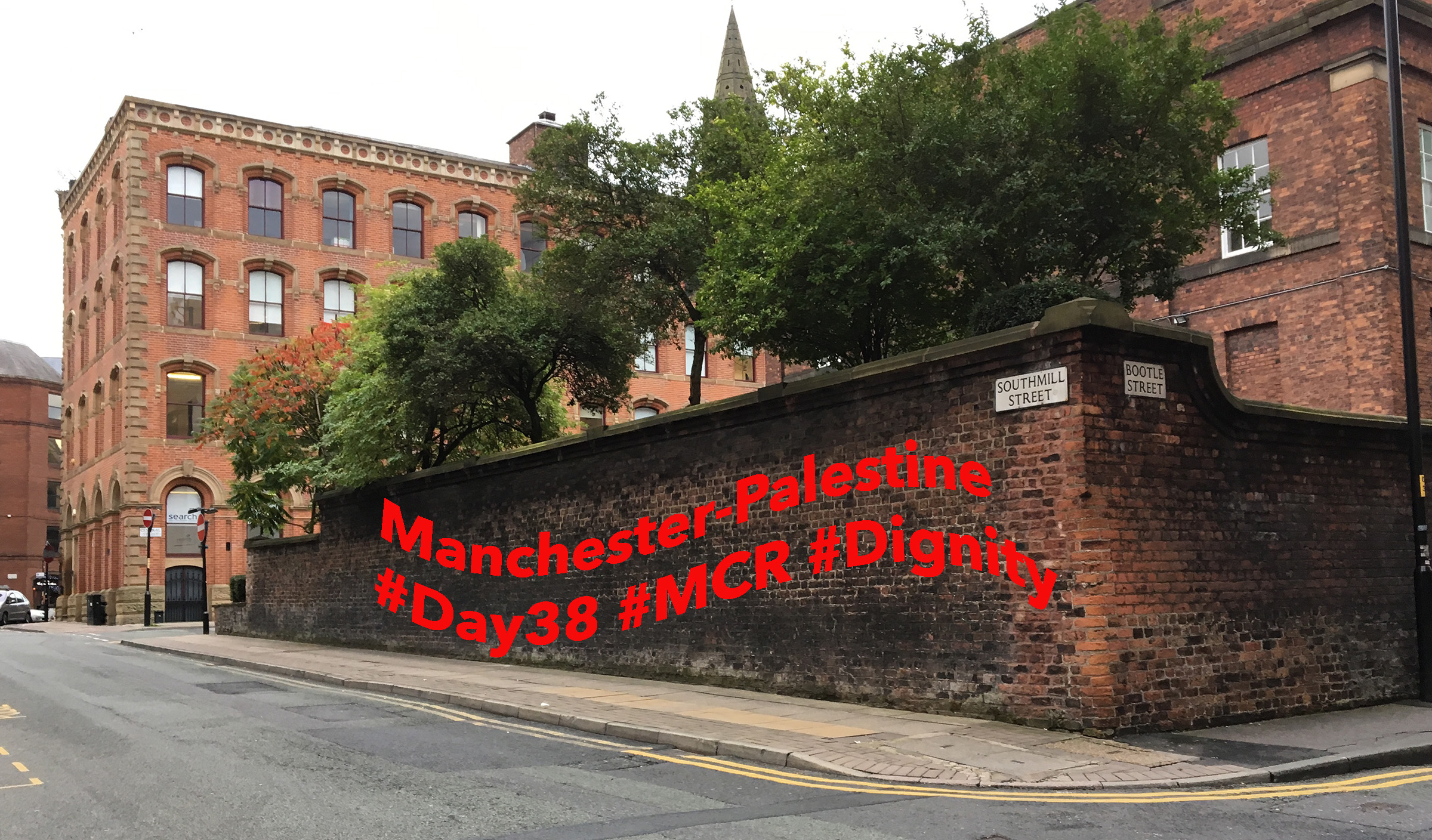For Manchester and Palestine, in solidarity
In the flash of the media cameras and the detonation of a bomb, Manchester and Palestine yesterday became a dialectical image of the present. The invisible, drawn-out suffering of the hunger strikers in Palestine shatters against the hypervisible instant of mass mediated murder. The clash of two sets of images produced a fragmented sense of the uneven time in which we live and die or, more exactly, live dying.
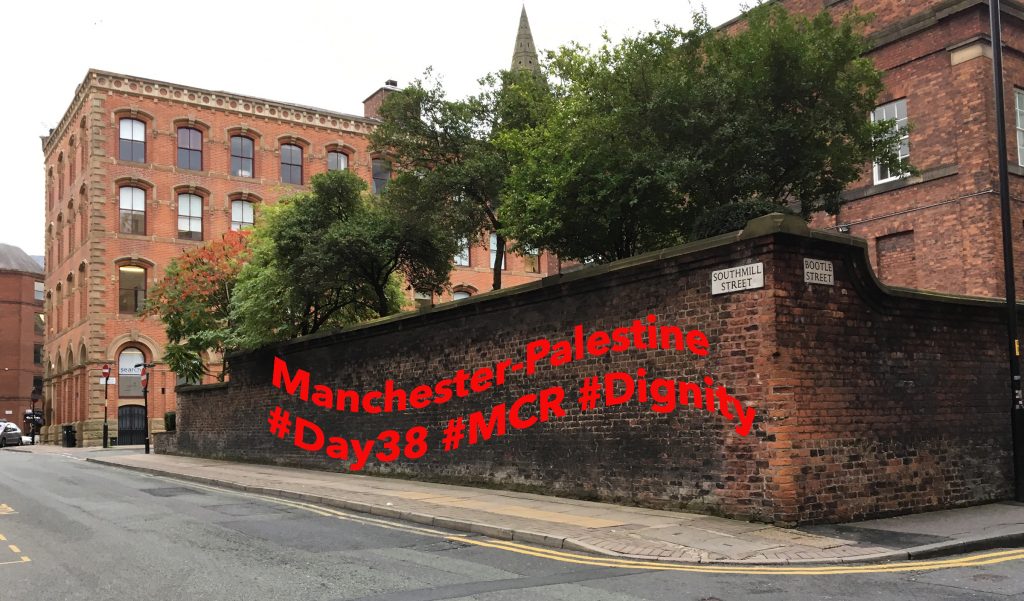
So many times were present in that moment. One could speak of the mediated spectacle of Ariana Grande in the home of the Industrial Revolution. Of the death of fifteen strikers in the Peterloo Massacre of 1815, less than a mile from the Manchester Arena. Of the gentrification of a city once known as “Gunchester.” Of the long unwinding of the British Mandate in Palestine and elsewhere in the Middle East. Of the static condition of “terrorism” and “counterinsurgency” that has persisted since the Cold War. And, above all, of the intersection of lived lives that ended because fascism is willing to use them to make its interventions.
manchester
The so-called suicide bomber does not have suicide as their primary goal. It is a means to the end of producing the impactful image, the place that will be remembered until the next detonation. The index was defined by Charles Sanders Pierce as the bullet hole that indexed the passing of a bullet. That was the analog photograph. In the age of the camera as data-gathering device, the explosion and its impact is now the index of the “image.” This “image” stems from the release of light and energy caused by a bomb. If it makes sense, as I think it does, to understand this as an “image,” it changes what is meant by that term. It perhaps explains the difficulty an actual photograph or video has in recording or making social change.
If we were to ask W. J. T. Mitchell’s famous question, “what does the picture want?” of such images, the answer would be “to create multiple deaths and injuries.” That is “impact” in the age of data-gathering and quantification. Such is the actuarial calculus of the mediated spectacle of death, the counterpart to the “message” sent by the cruise missile or the MOAB (Mother Of All Bombs). To whom are such messages sent? By what device are they to be recorded? The indexical image pointed to a moment in time. The impact image stops time. Think of the clocks and watches from Hiroshima, all stopped at 8.15 am, the time of detonation.
The goal of the insurgent and counterinsurgent is to create a battlefield that can then be visualized. Britain has rushed troops into the streets, as if in recognition that the bomb has succeeded in forming a new space of combat. The IRA bombings, like that in Manchester in 1996, were always “one-offs,” with specific targets. ISIS-style random attacks are designed to create the sense that there may be a series. It is, like it or not, insurgency for the socially-mediated network era. It is an image-event composed of a series of actual or potential “impacts.”
palestine
The Palestinian hunger strikers are, in the phrase of their Irish Republican counterparts in 1981, “going to the edge.” The temporalities here are the intersection of bodily time, the time of imprisonment and the fatal moment of release. Prisoners are making their bodies into icons by suffering, as Allen Feldman observed of the Irish hunger strike. There are, just as there were in 1981, furious denunciations that these are “just” violent criminals.How would those who are just see the strike, I wonder? Whether one accepts such charges or not, the time is different now. By striking to death, the hunger striker seeks to separate their physical bodies, which may or may not have done terrible things, from their iconic images as martyrs.
Watch, if you can, the video clip of prison officers dragging two hunger strikers into vans to be transferred to hospital. I don’t know who these people are, or what they have been accused or convicted of doing. But forcing them to walk when they have not eaten for thirty-eight days conveys the sense that the regime does not regard the prisoners as people. All Palestinians remain forbidden, until and unless they both “renounce” violence, as if it is a creed rather than an act, and “recognize” Israel, a form of seeing that would amount to self-denial. By contrast, any person of Jewish descent that does not so recognize the “right” of the regime to perpetrate such violence is “self-hating.”
But for the most part, the hunger strike is unseen, unmediated and, outside Palestine and those in solidarity with it, ignored. Further, those striking can do so only in the expectation of not actually seeing themselves as icons. They have taken the call to renunciation and turned into a form of self-directed action. In the words of one Irish Republican, hunger strikers use their own “bodies as a protest weapon.”
That is the “edge,” the rendering of the physical body into a counter-border. The power of this immaterial icon depends precisely on the time, forty to sixty days, it takes to starve oneself to death. By imposing a worse punishment on themselves than even the carceral state is prepared to mete out, the strikers defy its logic.
The messianic hope is that this defiance jumps the wall, as it were, and reaches the outside. By striking en masse–over a thousand are involved–the Palestinians are hoping to create a “wave” response to mass death. It is a perhaps deliberate contrast to the Irish hunger strike that went from person to person, but ended up diminishing the impact of subsequent deaths. It is astonishing what you can get used to seeing in the era of the mediated spectacle.
The icons of the hunger strike will be nothing in themselves unless they become a catalyst for change. The gamble is that the amount of time involved gives the regime plenty of time to prepare. When Bobby Sands died in 1981, Catholic areas in Belfast were sealed off and the British Army was in place. There will be no surprise, no time-stopping “impact” as there was in Manchester. Time is exactly what is in play.
Dialectics of oil
The dialectical image of the present does not operate within a philosophical “logic,” like that of Hegel. Rather it operates within the totalizing “logical” system that has demolished the balance of geological modernity, namely petrocracy, the mutually reinforcing rule of fossil fuels and monotheism.
Petrocracy is an autocratic state apparatus defined for and by the exploitation of fossil fuels, whose lineage can be traced back through the world-destroying projects of racial capitalism. Its presence today is self-evident from Putin’s gas-driven regime in Russia to Rex Tillerson, to the former CEO of Exxon-Mobil, now the Secretary of State in the United States and, of course, the entire Middle East and Gulf region oil regimes.
So it is no coincidence that this dialectical moment opened with the United States agreeing to sell armaments worth $110 billion to the autocrats of Saudi Arabia in the name of peace. The US regime appears to be attempting to reconfigure the Middle East from Saudi Arabia, in alliance with Israel, against Iran. In so doing, they remarkably ISIS, funded and backed by Saudi Arabia, as were the 9-11 hijackers.
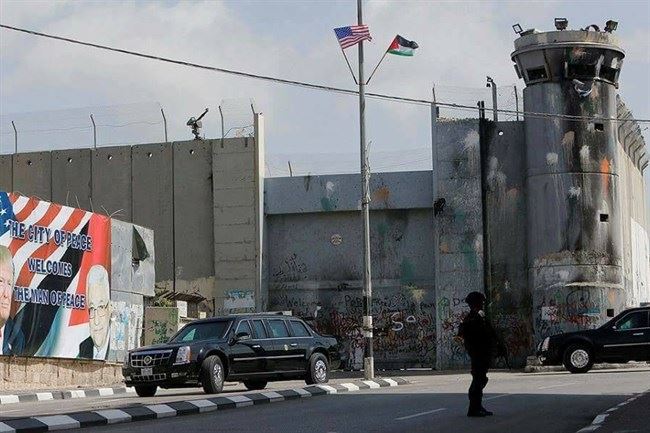
The illogical “logic” of petrocracy was encapsulated in this image of Trump’s motorcade passing Aida refugee camp in Bethlehem (thanks to Richard Reilly for posting it). Established in 1948 after the Nakba, Aida is now bordered by the Separation Wall on one side and Banksy’s new “Walled Off Hotel” on another. Both the Wall and the hotel serve as spaces for protest art. The insufficiency of such visual depictions in the face of the spectacle of “peace” is epitomized by the poster created for Trump’s 90 minute visit.
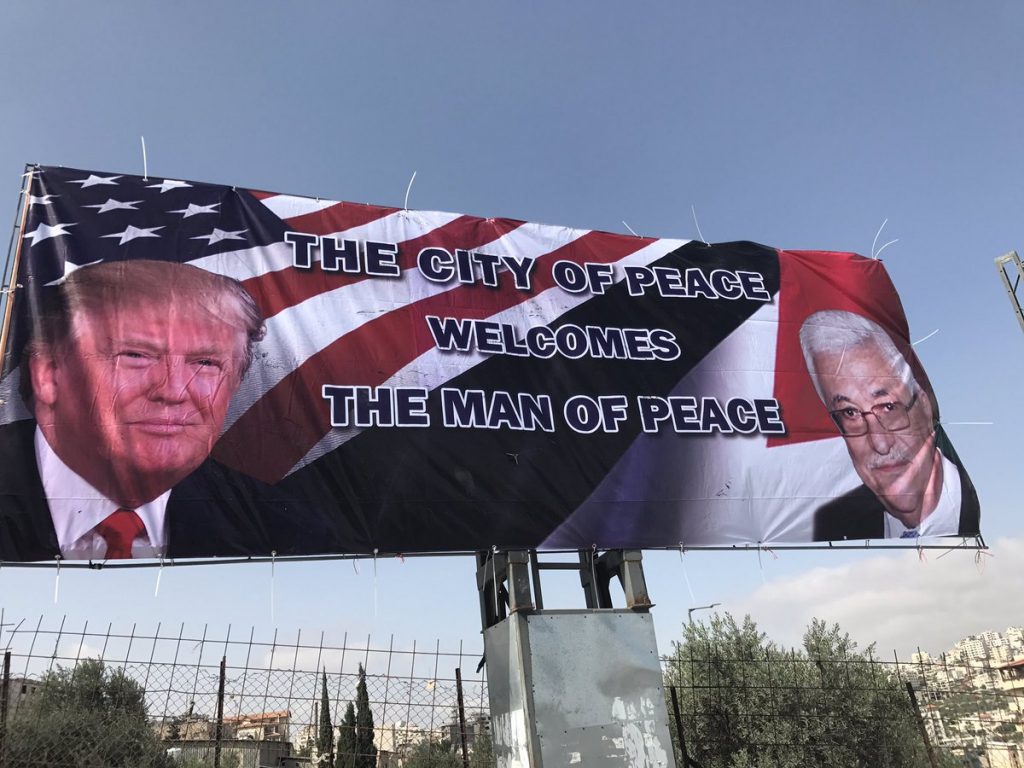
It says: “The city of peace welcomes the man of peace.” One can only presume that the “man of peace” is Trump and Abbas is simply content to share the visual field with him as a form of legitimation. “Peace” becomes a battlefield in which to be seen. The poster, in common with all the media coverage of the non-event of their meeting, served as a screen, preventing any possibility of the actually-existing conditions of Palestine actually being seen.
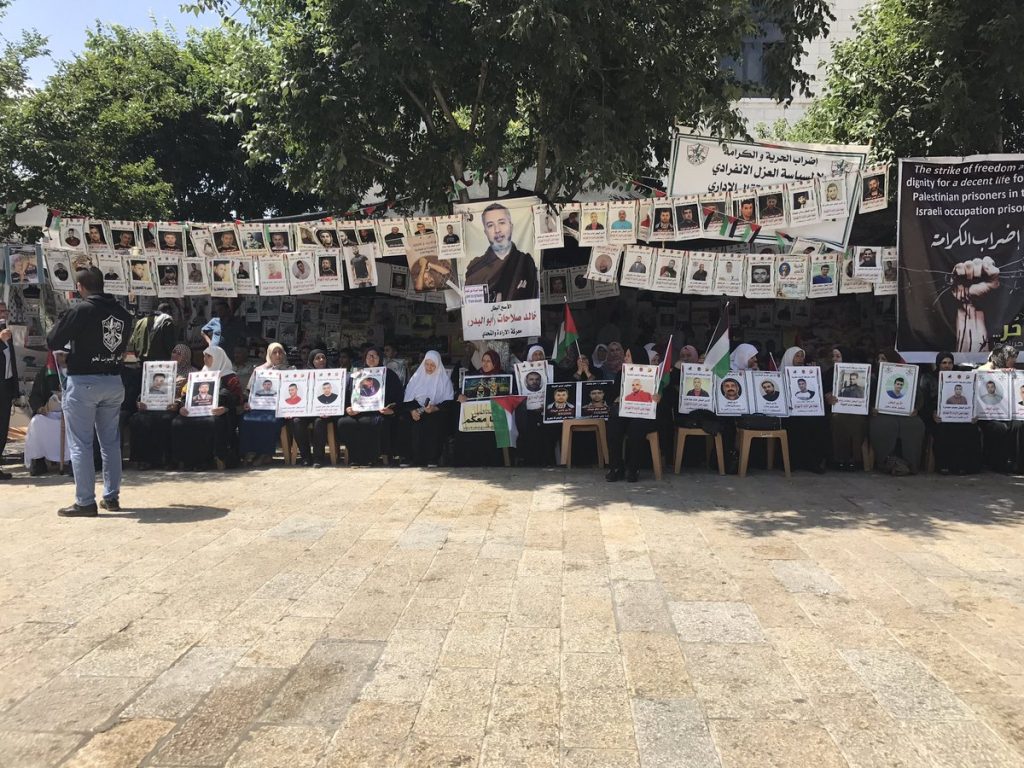
Outside the Church of the Nativity, a long line of mothers of hunger strikers awaited Trump. Despite his recent claim to Christianity, Trump skipped the visit and the potentially challenging confrontation was avoided. In Northern Ireland, mothers were often deployed by the British to break the strike, as Feldman documents. To have twenty-two mothers within this one shot willing to endorse their children starving themselves to death would, one might have thought, been worthy of mention.
The ISIS-style action in Manchester had as one of its effects the occlusion of the Palestinian protest and the hunger strike from what was its best chance of gaining international attention.
Dialectics of Resistance
In the 1960s, James Boggs considered the dialectic and the possibility of revolution in Detroit. After the Detroit Uprising of 1967, he and Grace Lee Boggs came to consider that a Bolshevik-style revolution was no longer possible. It changed his view of the dialectic:
Reforms and revolutions are created by the illogical actions of people. Very few logical people ever make reforms and none make revolutions. Rights are what you make and what you take.
Boggs anticipated an idea better known in the later work of Jacques Rancière–that rights are made by those who do not have them in circumstances where they are actually denied. Rosa Parks taking her seat in the bus had no right to do so but opened the way both to the reforms of the Civil Rights Movement and the possibility of revolution.
If the logic of petrocratic capital requires “illogical” responses, then dialectically that opens the possibility of fascist actions, like those of ISIS, to claim the rhetoric of anti-capitalism and anti-imperialism. Given their willingness to use the bodies of others to comprise their impact images, they garner media, military and political attention without parallel. I am not for one instant suggesting that radicals of the left should emulate or envy these actions. But just as Walter Benjamin noted the power of the fascist aesthetic in the 1930s, it would be foolish to pretend that the dialectic of the present is equal. Nor, as I have tried to show, can we respond like Benjamin with a simple injunction to politicize the “image.” That has been tried and it has failed and continues to fail.
Where the damned of the earth resist, we must be in solidarity and we must make that resistance visible, even and especially if it makes us uncomfortable and challenges some of our “givens.” The situation is new. The solutions we have are old. If not now, when?
